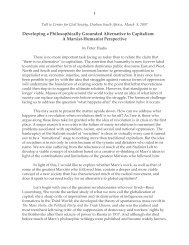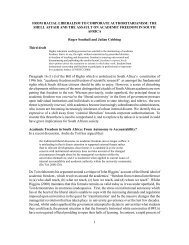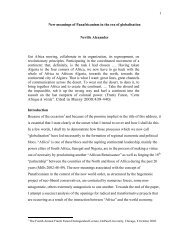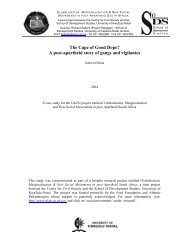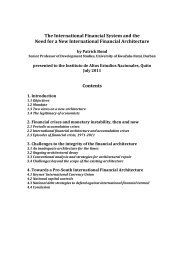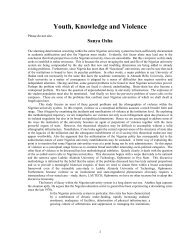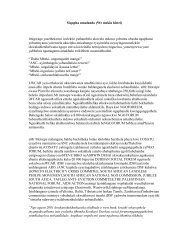April 2011 - Centre for Civil Society - University of KwaZulu-Natal
April 2011 - Centre for Civil Society - University of KwaZulu-Natal
April 2011 - Centre for Civil Society - University of KwaZulu-Natal
Create successful ePaper yourself
Turn your PDF publications into a flip-book with our unique Google optimized e-Paper software.
are jobless (nearly a million). Just over a million women have lost their<br />
jobs, mainly from the public sector.<br />
The total jobless would be much higher except <strong>for</strong> the increase in parttime<br />
(up to a record 1.16 million) and temporary jobs.<br />
But the worst jobs carnage is yet to come. The so-called Office <strong>for</strong> Budget<br />
Responsibility is predicting 490,000 public-sector job losses (out <strong>of</strong> six<br />
million) over the next five years. A cut on this scale will inevitably affect<br />
the private sector, causing even more job losses.<br />
Weak world economy<br />
Apart from spending cuts and job losses, a battery <strong>of</strong> other measures will<br />
cut into living standards: 20% VAT rate, 1% increase in National Insurance<br />
contributions, petrol and diesel price increases, rail and other fare<br />
increases. Verdict, the retail research group, predicts that average<br />
household disposable income will fall by 9.1% between <strong>2011</strong> and 2015. The<br />
average household is likely to be £2,200 worse <strong>of</strong>f. These are average<br />
figures, many families will be much worse <strong>of</strong>f.<br />
All this is unfolding against the background <strong>of</strong> a very fragile recovery in the<br />
world economy. There is still the possibility <strong>of</strong> a meltdown <strong>of</strong> the European<br />
banking system, a shock that would inevitably trigger another slump in the<br />
British economy.<br />
Osborne, Cable & Co opti-mistically point to the renewed vigour <strong>of</strong><br />
manufacturing. True, the devaluation <strong>of</strong> the pound (25% since 2008) has<br />
helped exports a bit, and the manufacturing sector grew by 0.9% in the<br />
last quarter. But it now accounts <strong>for</strong> only 12% <strong>of</strong> output (down from 25% in<br />
1980). This shrunken vestige cannot lift the wider economy.<br />
Manufacturing investment slum-ped during the recession (down 28%) and<br />
many big companies have piles <strong>of</strong> cash in the bank. Yet they are in no<br />
hurry to invest in new plant and equipment.<br />
Weak demand at home and stiff competition abroad means there is surplus<br />
capacity. According to the ONS: “firms are not sufficiently confident about<br />
the future to warrant a current rise in productive capacity”.<br />
Prices up, wages down<br />
Con-Dem ministers appear to have an almost mystical belief in a<br />
renaissance <strong>of</strong> the private sector, which will supposedly replace the jobs<br />
cut from the public sector.<br />
Yet the out-going director <strong>of</strong> the Confederation <strong>of</strong> British Industry, Sir<br />
Richard Lambert, slammed the government <strong>for</strong> having no industrial policy,<br />
no ‘vision’ <strong>for</strong> the future.<br />
Lambert, no friend <strong>of</strong> the working class, welcomes the Con-Dem’s deficit<br />
reduction measures. But he wants them to go much further with probusiness<br />
policies: lower taxes <strong>for</strong> businesses and the wealthy, further<br />
restrictions <strong>of</strong> trade union rights, curbing access to industrial tribunals,<br />
weaker health and safety legislation, and so on.<br />
The Bank <strong>of</strong> England has again held interest rates at a near-zero 0.5%. Two<br />
members <strong>of</strong> the bank’s Monetary Policy Committee (MPC) voted <strong>for</strong> a rate<br />
rise at its last meeting. These inflation hawks reflect pressure from many<br />
finance capitalists. Higher real (inflation-adjusted) rates favour lenders,<br />
while low or negative real rates erode the value <strong>of</strong> debt, benefitting<br />
borrowers.



